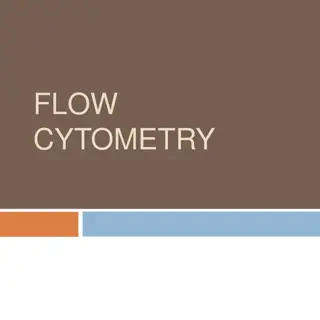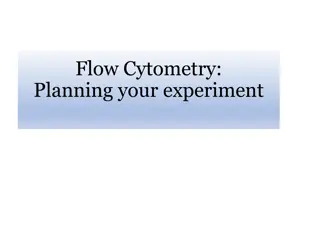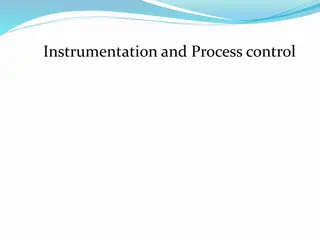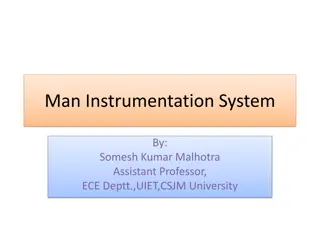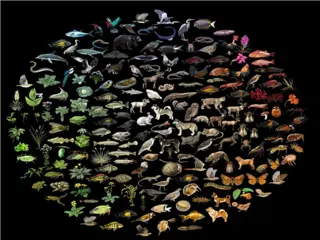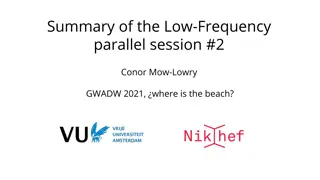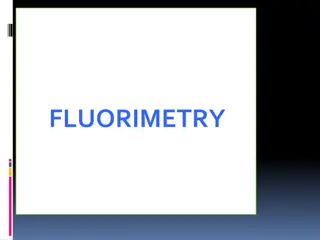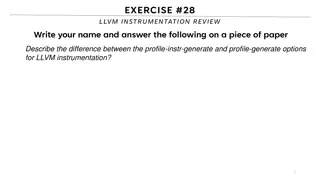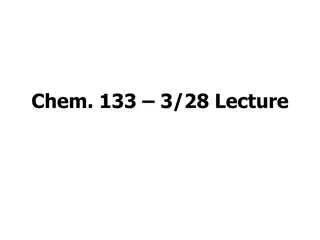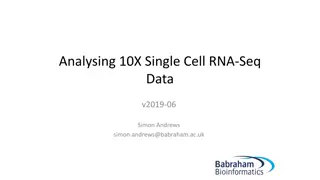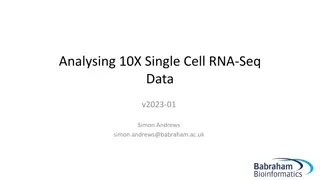Understanding Flow Cytometry Instrumentation and Cell Preparation
Flow cytometry is a valuable technique for analyzing multiple characteristics of cell populations. This overview delves into the features of BD LSRFortessa and BD Celesta flow cytometers, detailing their excitation lasers and detection filters. It also highlights the importance of proper cell preparation techniques such as cell digestion, isolation, and counting for optimal flow cytometry outcomes.
Download Presentation

Please find below an Image/Link to download the presentation.
The content on the website is provided AS IS for your information and personal use only. It may not be sold, licensed, or shared on other websites without obtaining consent from the author. Download presentation by click this link. If you encounter any issues during the download, it is possible that the publisher has removed the file from their server.
E N D
Presentation Transcript
Sample Prep Flow Cytometry: BD LSRFortessa BD Celesta
BDLSR Fortessa Excitation Laser Detection Filter Example 488 nm (blue) 695/40 (675-715 nm) PERCP/5.5, 7AAD, PERCP/EF710 515/20 (505-525 nm) AF488, GFP, FITC 561 nm (green) 780/60 (750-810 nm) PE-CY7 710/50 (685-735 nm) PE-CY5 670/30 (655-685 nm) PE-CY5.5 610/20 (600-630 nm) PE-TXRED, PI, MCHERRY, CF594 582/15 (574-590 nm) PE 633 nm (red) 780/60 (750-810 nm) APC-Cy7, APC-EF780 720/40 (700-740 nm) AF700 660/20 (650-670 nm) APC, AF647, EF660 407 nm (violet) 780/60 (750-810 nm) BV785, QD800 710/50 (685-735 nm) BV711 660/20 (650-670 nm) BV650, QD655 610/20 (600-630 nm) BV605, QD605 525/50 (500-550 nm) BV510, AMCYAN 450/50 (425-475 nm) DAPI, BV421, EF450, PACBLUE
BDLSRFortessa The Fortessa is a 16 color, 3 laser traditional flow cytometer. The samples are run by the core personnel and FCS files are created to be analyzed in FlowJo or similar software by the researcher. The Fortessa is commonly used for cell cycle, apoptosis, and cell surface and intracellular staining of up to 16 colors. All samples should be fixed to run on the Fortessa unless your assay prohibits (i.e. apoptosis). This allows for timing flexibility in running samples and eliminates biosafety concerns. A fixation protocol can be found here:
BD Celesta Excitation Laser 488 nm (Blue) Detection Filter 780/60 (750-810 nm) Example PE-CY7 695/40 (675-715 nm) PERCP, PERCP5.5, 7AAD, PERCP-EF710 575/25 (562-588 nm) PE 530/30 (545-515 nm) FITC, GFP, AF488 633 nm (red) 780/60 (750-810 nm) APC-Cy7, APC-EF780 720/40 (700-740 nm) AF700 660/20 (650-670 nm) APC, AF647, EF660 407 nm (violet) 780/60 (750-810 nm) BV711 660/20 (650-670 nm) BV650 610/20 (600-630 nm) BV605 525/50 (500-550 nm) BV510, AMCYAN 450/50 (425-475 nm) DAPI, BV421, EF450, PACBLUE
BD Celesta The BD Celesta is a 12 color traditional flow cytometer. Samples are run by the researcher. Prior training and authorization is required to operate this instrument. This instrument is ideal for use when your experiment requires after hours analysis. FCS files are created that are then analyzed on FlowJo or similar software by the researcher.
Preparing Cells All cell types require different digestion, harvesting, and isolation techniques. It is recommended you find a protocol specific for your cell type that gives you a single cell suspension with optimal cell number recovery. Lyse out red blood cells! This step is very important. RBCs will overwhelm your samples and make finding cells of interest very difficult. COUNT YOUR CELLS! This step is very important. After cell collection and prior to staining, count your cells. This will help you determine antibody concentrations, as well as determine if your cell harvest was successful and you have enough cells to stain. Unless you are identifying very rare cell populations, 1-5 million cells is a sufficient number needed for staining. Make sure you have a single cell suspension. If you see clumps in your sample, these cannot be run on the cytometer. They can damage the instrument and cause inaccurate results. All samples should be filtered through a 40 m cell strainer topped 5 ml FACs tube before bringing the samples to the flow core.
Staining Protocol All cell types require different variations to the staining protocol, so it s best to find protocols specific to your assay/cell type. There are many protocols available on-line and on antibody manufacturer websites. It is highly recommended that you test your protocols on a small sample size prior to staining a large number of cells/samples on valuable cells. Keep it simple to start. Do not use your two month highly expensive or valuable experimental samples for your first flow run. A generic staining protocol can be found on my website here: https://medicine.uams.edu/mbim/research-cores/flow- cytometry-core-facility/sample-submission/sample- preparation/
Experimental Quality Controls Quality control samples are needed with each experiment. Best practice is to prepare these with each run. A multi-color experiment cannot be run without proper controls. For best practice, the controls needed for each experiment are as follows: Negative/unstained cells Single stain controls for each color FMOs (fluorescence minus one) for each color. If only staining/sorting for a single color, then just a negative unstained control is required If you are using the same panel for multiple days of an experiment then settings can be re-used but additional compensation may be needed within FlowJo These controls are needed to set instrument voltages and compensate the samples, while the FMOs are used in analysis to set the positive and negative gates for each color (fluorophore).
Experimental Quality Controls The single stain/compensation controls are used to set up the instrument and samples cannot be run without them. Example: A panel stained with FITC=CD3, PE=CD4, APC=B220, and EF780=viability dye Tube 1. Cells only Tube 2. Cells stained with FITC CD3 only Tube 3. Cells stained with PE CD4 only Tube4. Cells stained with APC B220 only Tube 5. Cells stained with ef780 viability only
Experimental Quality Controls FMO controls are used for analysis purposes. When drawing gates to determine which proportion of the cell population expresses a given marker, these controls are used to help set the positive and negative gates. While some populations have clear pos/neg expression, low expressing markers or markers that just cause a slight shift are easier to confidently gate on with FMO controls FMO example: Using the same panel listed on previous slide FMO controls would be: Tube 6: FITC FMO- Cells with all stains except FITC Tube 7: PE FMO- Cells with all stains except PE Tube 8: APC FMO- Cells with all stains except APC Tube 9: ef780 viability FMO- Cells with all stains except ef780
Experimental Quality Controls Some cells types are prohibitive in the number of cells available, making it difficult to generate control samples. In these instances other options are available. For example, many researchers will use splenocytes or other abundant tissue types to harvest cells to stain for controls. Beads can also be used. Make sure that the sample/cells chosen for the single stain controls will express your marker. There has to be a positive population for the marker to accurately compensate. If you are unsure that the marker you are using is expressed by the cells in your assay, then chose another marker that is expressed to make this control. For example: Many researchers use CD4 for all the single stain controls to ensure good expression. The marker can differ from the one in your panel as long as it s the same color and expressed by cells in your sample.
Samples Samples must be in 5ml- 12x75mm polystyrene round bottom tubes BD Flacon brand (catalog # 352052) to be ran on Fortessa or Celesta. No other sized tubes will work. The recommended sample concentration is 10 million cells/ml and adjust according to your cell count with a minimum final volume of 200 ul. If cells are over diluted, it causes unnecessary long run times. Filter cells prior to bringing to the core. If aggregates are present, the samples cannot be ran as it will clog the instrument. Include a form with samples indicating all necessary info: Lab name, your name, contact info, staining panel including markers & colors used, cell type, etc. This must be submitted with samples, or it can be emailed to core personnel ahead of time. Make sure tubes are numbered or labeled legibly to prevent mishandling of tubes out of order. Samples can be dropped off in core fridge or in afterhours fridge prior to appointment time.


